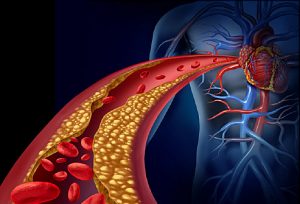
Plaque in a Heart Artery filled with Foam Cells
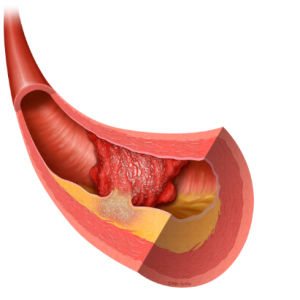 A heart attack happens when a medium sized cholesterol and lipid filled plaque (deposit) covered with a layer of scar tissue in a heart artery becomes inflamed and ruptures. This exposes a rough surface to which platelets adhere and start the clotting process just as they would if we had cut our skin. In the presence of inflammation normal counter forces that would limit the growth of the clot and eventually dissolve it are inhibited and the clots often grow large enough to block blood flow in this heart artery causing part of the heart to be starved for blood flow, eventually leading to the death of heart cells (see illustration to the right of a heart artery with a clot formed over a ruptured plaque which blocked the blood flow).
A heart attack happens when a medium sized cholesterol and lipid filled plaque (deposit) covered with a layer of scar tissue in a heart artery becomes inflamed and ruptures. This exposes a rough surface to which platelets adhere and start the clotting process just as they would if we had cut our skin. In the presence of inflammation normal counter forces that would limit the growth of the clot and eventually dissolve it are inhibited and the clots often grow large enough to block blood flow in this heart artery causing part of the heart to be starved for blood flow, eventually leading to the death of heart cells (see illustration to the right of a heart artery with a clot formed over a ruptured plaque which blocked the blood flow).
So do high Cholesterol levels cause heart attacks since the plaques are full of Cholesterol?
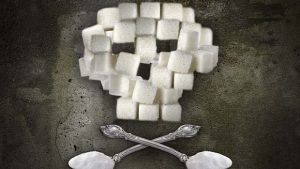 The answer that most closely fits with all the scientific data we have on the problem is that Cholesterol has nothing to do with it. It is high glucose levels in the blood that cause the initial inflammation and artery damage that ultimately leads to heart attacks and that in most cases these high blood sugar levels are caused by a diet high in Sucrose or Table Sugar. Starches and grains are high in glucose but do not contain a sugar called fructose or fruit sugar. That’s why people like the Japanese who used to eat a lot of rice but very little sugar did not get very much heart disease. Interestingly as the Japanese have increased their sugar consumption, heart disease and diabetes have risen equally quickly in Japan. Sucrose (table sugar) on the other hand is 50% fructose. So why is fructose so bad? First it is an avid oxidizing agent. This means it readily binds to proteins throughout our body damaging them and causing inflammation. It binds 8 times as readily as glucose. Second very few cells in our body are able to metabolize fructose. Almost all fructose in our bodies must be processed in the liver in the same pathway as alcohol and just like alcohol puts us at high risk of fatty liver. Right now over ⅓ of all Americans suffer from fatty liver disease. As this article shows fatty liver disease often leads to insulin resistance which causes high blood sugars especially in people who eat a lot of carbohydrates.
The answer that most closely fits with all the scientific data we have on the problem is that Cholesterol has nothing to do with it. It is high glucose levels in the blood that cause the initial inflammation and artery damage that ultimately leads to heart attacks and that in most cases these high blood sugar levels are caused by a diet high in Sucrose or Table Sugar. Starches and grains are high in glucose but do not contain a sugar called fructose or fruit sugar. That’s why people like the Japanese who used to eat a lot of rice but very little sugar did not get very much heart disease. Interestingly as the Japanese have increased their sugar consumption, heart disease and diabetes have risen equally quickly in Japan. Sucrose (table sugar) on the other hand is 50% fructose. So why is fructose so bad? First it is an avid oxidizing agent. This means it readily binds to proteins throughout our body damaging them and causing inflammation. It binds 8 times as readily as glucose. Second very few cells in our body are able to metabolize fructose. Almost all fructose in our bodies must be processed in the liver in the same pathway as alcohol and just like alcohol puts us at high risk of fatty liver. Right now over ⅓ of all Americans suffer from fatty liver disease. As this article shows fatty liver disease often leads to insulin resistance which causes high blood sugars especially in people who eat a lot of carbohydrates.
So how can high blood sugars lead to plaques in the arteries of the heart and brain that cause heart attacks and strokes (it’s the same process)?
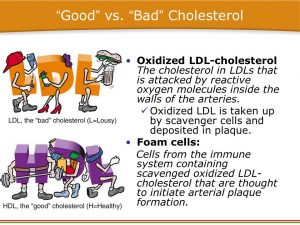 The process is called “endothelial dysfunction” and high Cholesterol and normal healthy LDL particle levels have nothing to do with it. The endothelial cells that line our arteries do not require insulin to let sugar inside them and so the level of glucose in these cells is always the same as in the blood stream. High glucose in these cells causes direct damage to proteins that compose them and high free radical production in the mitochondria which leads to inflammation which leads these endothelial cells to produce proteins on their surface that signal infection fighting White blood cells called macrophages to congregate in the area because there may be an infection. The macrophages migrate under the endothelial cells and watch for a germ or anything foreign to the body that might be causing the inflammation. This is where Cholesterol comes into the picture. The macrophages fill up with LDL Cholesterol particles but not with normal LDL Cholesterol particles only with ones that are small and oxidized.
The process is called “endothelial dysfunction” and high Cholesterol and normal healthy LDL particle levels have nothing to do with it. The endothelial cells that line our arteries do not require insulin to let sugar inside them and so the level of glucose in these cells is always the same as in the blood stream. High glucose in these cells causes direct damage to proteins that compose them and high free radical production in the mitochondria which leads to inflammation which leads these endothelial cells to produce proteins on their surface that signal infection fighting White blood cells called macrophages to congregate in the area because there may be an infection. The macrophages migrate under the endothelial cells and watch for a germ or anything foreign to the body that might be causing the inflammation. This is where Cholesterol comes into the picture. The macrophages fill up with LDL Cholesterol particles but not with normal LDL Cholesterol particles only with ones that are small and oxidized.
So where do these small oxidized LDL Cholesterol particles come from?
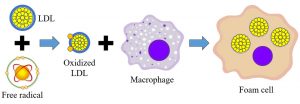 They are normal LDL Cholesterol particles that have stayed in circulation too long because a high carb diet in an insulin resistant person has elevated the blood triglyceride level preventing these LDL particles from reaching the size where they are normally taken up by the liver and recycled. This is because the job of LDL particles is to live 24-48 hours and deliver triglycerides and Cholesterol to cells that need these nutrients (all cells in the body need Cholesterol as it is part of what makes up their cell membrane and many hormones and structural components are made from Cholesterol). However when blood triglycerides (simple fats) levels are high the LDL particles keep picking it up to try to get these abnormal blood levels down. The LDL particles must shrink down to around ½ their initial size to be taken up and reprocessed by the liver so they hang around past their expiration date in the blood stream and risk getting oxidized. Oxidation is the process where an oxidizing agent in the blood like glucose or fructose binds to them causing them to become small and oxidized.
They are normal LDL Cholesterol particles that have stayed in circulation too long because a high carb diet in an insulin resistant person has elevated the blood triglyceride level preventing these LDL particles from reaching the size where they are normally taken up by the liver and recycled. This is because the job of LDL particles is to live 24-48 hours and deliver triglycerides and Cholesterol to cells that need these nutrients (all cells in the body need Cholesterol as it is part of what makes up their cell membrane and many hormones and structural components are made from Cholesterol). However when blood triglycerides (simple fats) levels are high the LDL particles keep picking it up to try to get these abnormal blood levels down. The LDL particles must shrink down to around ½ their initial size to be taken up and reprocessed by the liver so they hang around past their expiration date in the blood stream and risk getting oxidized. Oxidation is the process where an oxidizing agent in the blood like glucose or fructose binds to them causing them to become small and oxidized.
What can we do to make sure our LDL Cholesterol is the healthy, large fluffy variety?
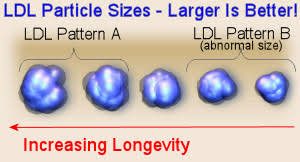 Simple, stop eating carbohydrates. Low carbohydrate diets have been shown to cause our LDL to become larger and fluffier. High carb diets have the opposite effect. And fructose, the sugar found in table sugar and fructose is 8 times as bad for your LDL Cholesterol. Here’s a quote from this article in Current opinion in clinical nutrition and metabolic care: “Studies conducted during the past few years have quite unanimously shown that the quantity of carbohydrates ingested is associated with a decrease of LDL particle size and an increase in its density. Conversely, diets that aim at a reduction of carbohydrate intake are able to improve LDL quality. Furthermore, a reduction of the glycaemic index without changing the amount of carbohydrates ingested has similar effects. Diseases with altered carbohydrate metabolism, for example, type 2 diabetes, are associated with small, dense LDL particles. Finally, even the kind of monosaccharide the carbohydrate intake consists of is important concerning LDL particle size: fructose has been shown to alter the LDL particle subclass profile more adversely than glucose in many recent studies.”
Simple, stop eating carbohydrates. Low carbohydrate diets have been shown to cause our LDL to become larger and fluffier. High carb diets have the opposite effect. And fructose, the sugar found in table sugar and fructose is 8 times as bad for your LDL Cholesterol. Here’s a quote from this article in Current opinion in clinical nutrition and metabolic care: “Studies conducted during the past few years have quite unanimously shown that the quantity of carbohydrates ingested is associated with a decrease of LDL particle size and an increase in its density. Conversely, diets that aim at a reduction of carbohydrate intake are able to improve LDL quality. Furthermore, a reduction of the glycaemic index without changing the amount of carbohydrates ingested has similar effects. Diseases with altered carbohydrate metabolism, for example, type 2 diabetes, are associated with small, dense LDL particles. Finally, even the kind of monosaccharide the carbohydrate intake consists of is important concerning LDL particle size: fructose has been shown to alter the LDL particle subclass profile more adversely than glucose in many recent studies.”
So why do the Macrophages in the inflamed artery fill up with small, oxidized LDL particles? 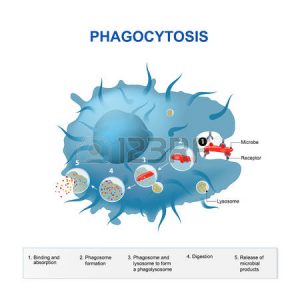 Because Marcrophages are white blood cells of the immune system whose job is to recognize foreign proteins that are not normally part of the body. The oxidized LDL particles are just the right size to pass through the lining of the arteries (normal LDL particles are too big) and the Macrophages see them as foreign invaders and gobble them up through a process called phagocytosis. When they get full of them they are called “foam cells” because they are big, fat and bubbly looking under the microscope. As part of the attack on the abnormal LDL particles macrophages produce inflammatory chemicals which starts the process of inflammation making the plaques weak. They body covers these “sores” on the artery with smooth muscle cells that then become dead scar tissue in an attempt repair the damage.
Because Marcrophages are white blood cells of the immune system whose job is to recognize foreign proteins that are not normally part of the body. The oxidized LDL particles are just the right size to pass through the lining of the arteries (normal LDL particles are too big) and the Macrophages see them as foreign invaders and gobble them up through a process called phagocytosis. When they get full of them they are called “foam cells” because they are big, fat and bubbly looking under the microscope. As part of the attack on the abnormal LDL particles macrophages produce inflammatory chemicals which starts the process of inflammation making the plaques weak. They body covers these “sores” on the artery with smooth muscle cells that then become dead scar tissue in an attempt repair the damage.
So we now have the perfect setting for a heart attack or stroke and Cholesterol and LDL were innocent bystanders that became suspects in the crime purely on circumstantial evidence the people started making billions selling medicines to lower them and are not interested in listening to exonerating evidence.
So why do Cholesterol medicines called statins like Lipitor and Crestor prevent heart attacks?
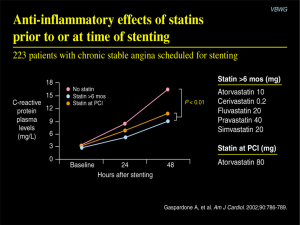 Well the effect is weak to start with and only really significant at all in people who have already had a heart attack. Many people myself included feel it is their mild anti-inflammatory property that is responsible for any benefits seen from them and their ability to lower Cholesterol is incidental and often deleterious. As you can see from the table to the right statins reduce C-Reactive Protein (one of the most sensitive measures of inflammation in the body). But they are known to damage nerve conduction for instance as this study shows. For more information on statins see my post Statin Risks and Cholesterol Benefits Your Doctor May Have Failed to Mention.
Well the effect is weak to start with and only really significant at all in people who have already had a heart attack. Many people myself included feel it is their mild anti-inflammatory property that is responsible for any benefits seen from them and their ability to lower Cholesterol is incidental and often deleterious. As you can see from the table to the right statins reduce C-Reactive Protein (one of the most sensitive measures of inflammation in the body). But they are known to damage nerve conduction for instance as this study shows. For more information on statins see my post Statin Risks and Cholesterol Benefits Your Doctor May Have Failed to Mention.
Many people who start low carb, high fat diets see their total and LDL Cholesterols go up, sometime dramatically and sometimes they actually go down. In my case, mine went up to levels that would make most doctors immediately recommend a statin medication. I would have done the same 5 years ago. I now understand what is going on and would not consider a statin medication. The answer is to get rid of the carbs and especially the sugar which is the root cause of heart disease. This will dramatically reduce your risk of heart disease, a statin is only a bandaid that in most cases does very little to lower the risk.
If you would like to discuss this further or have other data, please join my Facebook Group “Zero Carb Doc”, email me at ZeroCarbDoc@gmail.com or comment on this post.

 A heart attack happens when a medium sized cholesterol and lipid filled plaque (deposit) covered with a layer of scar tissue in a heart artery becomes inflamed and ruptures. This exposes a rough surface to which platelets adhere and start the clotting process just as they would if we had cut our skin. In the presence of inflammation normal counter forces that would limit the growth of the clot and eventually dissolve it are inhibited and the clots often grow large enough to block blood flow in this heart artery causing part of the heart to be starved for blood flow, eventually leading to the death of heart cells (see illustration to the right of a heart artery with a clot formed over a ruptured plaque which blocked the blood flow).
A heart attack happens when a medium sized cholesterol and lipid filled plaque (deposit) covered with a layer of scar tissue in a heart artery becomes inflamed and ruptures. This exposes a rough surface to which platelets adhere and start the clotting process just as they would if we had cut our skin. In the presence of inflammation normal counter forces that would limit the growth of the clot and eventually dissolve it are inhibited and the clots often grow large enough to block blood flow in this heart artery causing part of the heart to be starved for blood flow, eventually leading to the death of heart cells (see illustration to the right of a heart artery with a clot formed over a ruptured plaque which blocked the blood flow).  The answer that most closely fits with all the scientific data we have on the problem is that Cholesterol has nothing to do with it. It is high glucose levels in the blood that cause the initial inflammation and artery damage that ultimately leads to heart attacks and that in most cases these high blood sugar levels are caused by a diet high in Sucrose or Table Sugar. Starches and grains are high in glucose but do not contain a sugar called fructose or fruit sugar. That’s why people like the Japanese who used to eat a lot of rice but very little sugar did not get very much heart disease. Interestingly as the Japanese have increased their sugar consumption, heart disease and diabetes have risen equally quickly in Japan. Sucrose (table sugar) on the other hand is 50% fructose. So why is fructose so bad? First it is an avid oxidizing agent. This means it readily binds to proteins throughout our body damaging them and causing inflammation. It binds 8 times as readily as glucose. Second very few cells in our body are able to metabolize fructose. Almost all fructose in our bodies must be processed in the liver in the same pathway as alcohol and just like alcohol puts us at high risk of fatty liver. Right now over ⅓ of all Americans suffer from fatty liver disease. As this article shows fatty liver disease often leads to insulin resistance which causes high blood sugars especially in people who eat a lot of carbohydrates.
The answer that most closely fits with all the scientific data we have on the problem is that Cholesterol has nothing to do with it. It is high glucose levels in the blood that cause the initial inflammation and artery damage that ultimately leads to heart attacks and that in most cases these high blood sugar levels are caused by a diet high in Sucrose or Table Sugar. Starches and grains are high in glucose but do not contain a sugar called fructose or fruit sugar. That’s why people like the Japanese who used to eat a lot of rice but very little sugar did not get very much heart disease. Interestingly as the Japanese have increased their sugar consumption, heart disease and diabetes have risen equally quickly in Japan. Sucrose (table sugar) on the other hand is 50% fructose. So why is fructose so bad? First it is an avid oxidizing agent. This means it readily binds to proteins throughout our body damaging them and causing inflammation. It binds 8 times as readily as glucose. Second very few cells in our body are able to metabolize fructose. Almost all fructose in our bodies must be processed in the liver in the same pathway as alcohol and just like alcohol puts us at high risk of fatty liver. Right now over ⅓ of all Americans suffer from fatty liver disease. As this article shows fatty liver disease often leads to insulin resistance which causes high blood sugars especially in people who eat a lot of carbohydrates.  The process is called “endothelial dysfunction” and high Cholesterol and normal healthy LDL particle levels have nothing to do with it. The endothelial cells that line our arteries do not require insulin to let sugar inside them and so the level of glucose in these cells is always the same as in the blood stream. High glucose in these cells causes direct damage to proteins that compose them and high free radical production in the mitochondria which leads to inflammation which leads these endothelial cells to produce proteins on their surface that signal infection fighting White blood cells called macrophages to congregate in the area because there may be an infection. The macrophages migrate under the endothelial cells and watch for a germ or anything foreign to the body that might be causing the inflammation. This is where Cholesterol comes into the picture. The macrophages fill up with LDL Cholesterol particles but not with normal LDL Cholesterol particles only with ones that are small and oxidized.
The process is called “endothelial dysfunction” and high Cholesterol and normal healthy LDL particle levels have nothing to do with it. The endothelial cells that line our arteries do not require insulin to let sugar inside them and so the level of glucose in these cells is always the same as in the blood stream. High glucose in these cells causes direct damage to proteins that compose them and high free radical production in the mitochondria which leads to inflammation which leads these endothelial cells to produce proteins on their surface that signal infection fighting White blood cells called macrophages to congregate in the area because there may be an infection. The macrophages migrate under the endothelial cells and watch for a germ or anything foreign to the body that might be causing the inflammation. This is where Cholesterol comes into the picture. The macrophages fill up with LDL Cholesterol particles but not with normal LDL Cholesterol particles only with ones that are small and oxidized.  They are normal LDL Cholesterol particles that have stayed in circulation too long because a high carb diet in an insulin resistant person has elevated the blood triglyceride level preventing these LDL particles from reaching the size where they are normally taken up by the liver and recycled. This is because the job of LDL particles is to live 24-48 hours and deliver triglycerides and Cholesterol to cells that need these nutrients (all cells in the body need Cholesterol as it is part of what makes up their cell membrane and many hormones and structural components are made from Cholesterol). However when blood triglycerides (simple fats) levels are high the LDL particles keep picking it up to try to get these abnormal blood levels down. The LDL particles must shrink down to around ½ their initial size to be taken up and reprocessed by the liver so they hang around past their expiration date in the blood stream and risk getting oxidized. Oxidation is the process where an oxidizing agent in the blood like glucose or fructose binds to them causing them to become small and oxidized.
They are normal LDL Cholesterol particles that have stayed in circulation too long because a high carb diet in an insulin resistant person has elevated the blood triglyceride level preventing these LDL particles from reaching the size where they are normally taken up by the liver and recycled. This is because the job of LDL particles is to live 24-48 hours and deliver triglycerides and Cholesterol to cells that need these nutrients (all cells in the body need Cholesterol as it is part of what makes up their cell membrane and many hormones and structural components are made from Cholesterol). However when blood triglycerides (simple fats) levels are high the LDL particles keep picking it up to try to get these abnormal blood levels down. The LDL particles must shrink down to around ½ their initial size to be taken up and reprocessed by the liver so they hang around past their expiration date in the blood stream and risk getting oxidized. Oxidation is the process where an oxidizing agent in the blood like glucose or fructose binds to them causing them to become small and oxidized.  Simple, stop eating carbohydrates. Low carbohydrate diets have been shown to cause our LDL to become larger and fluffier. High carb diets have the opposite effect. And fructose, the sugar found in table sugar and fructose is 8 times as bad for your LDL Cholesterol. Here’s a quote from this article in Current opinion in clinical nutrition and metabolic care: “Studies conducted during the past few years have quite unanimously shown that the quantity of carbohydrates ingested is associated with a decrease of LDL particle size and an increase in its density. Conversely, diets that aim at a reduction of carbohydrate intake are able to improve LDL quality. Furthermore, a reduction of the glycaemic index without changing the amount of carbohydrates ingested has similar effects. Diseases with altered carbohydrate metabolism, for example, type 2 diabetes, are associated with small, dense LDL particles. Finally, even the kind of monosaccharide the carbohydrate intake consists of is important concerning LDL particle size: fructose has been shown to alter the LDL particle subclass profile more adversely than glucose in many recent studies.”
Simple, stop eating carbohydrates. Low carbohydrate diets have been shown to cause our LDL to become larger and fluffier. High carb diets have the opposite effect. And fructose, the sugar found in table sugar and fructose is 8 times as bad for your LDL Cholesterol. Here’s a quote from this article in Current opinion in clinical nutrition and metabolic care: “Studies conducted during the past few years have quite unanimously shown that the quantity of carbohydrates ingested is associated with a decrease of LDL particle size and an increase in its density. Conversely, diets that aim at a reduction of carbohydrate intake are able to improve LDL quality. Furthermore, a reduction of the glycaemic index without changing the amount of carbohydrates ingested has similar effects. Diseases with altered carbohydrate metabolism, for example, type 2 diabetes, are associated with small, dense LDL particles. Finally, even the kind of monosaccharide the carbohydrate intake consists of is important concerning LDL particle size: fructose has been shown to alter the LDL particle subclass profile more adversely than glucose in many recent studies.” Because Marcrophages are white blood cells of the immune system whose job is to recognize foreign proteins that are not normally part of the body. The oxidized LDL particles are just the right size to pass through the lining of the arteries (normal LDL particles are too big) and the Macrophages see them as foreign invaders and gobble them up through a process called phagocytosis. When they get full of them they are called “foam cells” because they are big, fat and bubbly looking under the microscope. As part of the attack on the abnormal LDL particles macrophages produce inflammatory chemicals which starts the process of inflammation making the plaques weak. They body covers these “sores” on the artery with smooth muscle cells that then become dead scar tissue in an attempt repair the damage.
Because Marcrophages are white blood cells of the immune system whose job is to recognize foreign proteins that are not normally part of the body. The oxidized LDL particles are just the right size to pass through the lining of the arteries (normal LDL particles are too big) and the Macrophages see them as foreign invaders and gobble them up through a process called phagocytosis. When they get full of them they are called “foam cells” because they are big, fat and bubbly looking under the microscope. As part of the attack on the abnormal LDL particles macrophages produce inflammatory chemicals which starts the process of inflammation making the plaques weak. They body covers these “sores” on the artery with smooth muscle cells that then become dead scar tissue in an attempt repair the damage.  Well the effect is weak to start with and only really significant at all in people who have already had a heart attack. Many people myself included feel it is their mild anti-inflammatory property that is responsible for any benefits seen from them and their ability to lower Cholesterol is incidental and often deleterious. As you can see from the table to the right statins reduce C-Reactive Protein (one of the most sensitive measures of inflammation in the body). But they are known to damage nerve conduction for instance as this study shows. For more information on statins see my post Statin Risks and Cholesterol Benefits Your Doctor May Have Failed to Mention.
Well the effect is weak to start with and only really significant at all in people who have already had a heart attack. Many people myself included feel it is their mild anti-inflammatory property that is responsible for any benefits seen from them and their ability to lower Cholesterol is incidental and often deleterious. As you can see from the table to the right statins reduce C-Reactive Protein (one of the most sensitive measures of inflammation in the body). But they are known to damage nerve conduction for instance as this study shows. For more information on statins see my post Statin Risks and Cholesterol Benefits Your Doctor May Have Failed to Mention.
Thank you for Posting this very informative & interesting READ! I’m more determined than ever to learn all I can about the Low Carb High Fat / KETO Lifestyle. Although I’ve been at this since 2009, I’ve tweaked and adjusted my original Low Carb Eating Plan till it barely resembles what I originally started doing. At that time, in 2009, I would find the lowest carb bread product and have a 1/2 slice and then fight the cravings to have more. I NO longer do that!! I also was afraid to eat FAT….I researched enough, till I NO longer do that! Love Learning….
Thank you!
This is a very fine report. I find it is as easy to understand as can reasonably be expected for a complex subject. Well done. Still, I wonder if the macrophages really enter through the lumen side or from the outside via the blood vessels permeating the core of the arteries such as outlined in work done by Subbotin.
You may well be right John. I’m sure the high blood glucose levels also cause inflammation in these arterioles. The process can be seen in arteries all over the body. When it happens in the arteries feeding the legs and plaques become so big that they restrict blood flow to the legs people develop a condition called Claudication. When they try to walk fast or for an extended period their body cannot pump enough blood past these blockages in the arteries leading to the legs and they developed severe burning pain with any lower extremity exertion. When it happens in the neck it can totally block the carotid arteries supplying the brain and can lead to stroke like symptoms called transient ischemic attack. One of the carotid arteries can become completely blocked. And it’s all about the sugar. As Dr. Yudkin called his book published in 1972 – “Pure, White and Deadly”
I recently had a LD(a) test that was 60,my triglycerides had come down from 279 in Jan to 170 now. I’ve also lost 25Lbs (5’8″ 185)
How worried should I be about the LD(a)? I’m now on a Keto diet.
LD(a) is one of those obscure not well understood tests where a high reading has a statistical association with heart disease but also with inflammation. As inflammation comes down so should LD(a). Since their is no recognized treatment for high LDa I question the logic of even getting the test. If you’re worried about heart attack risk why not get the best predictor, a Coronary Artery Calcium Score. But even if my were high my answer to the best treatment would be a low carb, high fat, no sugar diet.
I believe that niacin has been shown effective in lowering Lp(a).
Niacin has been shown not decrease heart disease risk: AIM-HIGH Investigators et al. Niacin in patients with low HDL cholesterol levels receiving intensive statin therapy. N Engl J Med. 2011;365:2255–2267. [PubMed] AIM-HIGH was the first double-blind, randomized, multicenter trial to assess the effect on cardiovascular events of adding extended-release niacin to statin-treated patients with established ASCVD and atherogenic dyslipidemia with well-controlled LDL-C. The study demonstrated a lack of efficacy of niacin in improving cardiovascular outcomes and was halted early after 3 years of follow-up
34. HPS2-THRIVE Collaborative Group et al.
Hi Dr Paul,
Thanks for this info. My doctor was impressed with my first-ever-since menopause significant weight loss (I’m 60), and my ‘distance’ from diabetes, from a blood test reading – the first I’ve had since Jan when I went zero carb – but nearly had a fit when he saw my cholesterol reading, which he said was waaaay too high.
I shall now email this article and see what he says.
I must say though; the old life-long conditioning about fats’ danger to arteries is still an issue I have to deal with on a daily basis 🙁 Other than that though, I’ve never felt better and am free of the sugar cravings for the first time in decades.
One question: if I’ve had metabolic syndrome for decades and am only recently starting to address this by going zero carb, am I able to undo the damage I’ve caused to my system?
Anne, Australia
Anne, I think that the metabolic syndrome is caused in susceptible people (at least 60% of the earth’s population) by sugar. Once you have it you cannot tolerate very much carbohydrate or high levels of protein. From what I’ve seen people report on Zero Carb blogs it seems to me that people who are younger and were fat for a shorter period can regain the ability to tolerate much greater amounts of carbohydrate and protein without getting fat or having high blood sugars. People who like me were sugar abusers for 62 years may never regain the ability to tolerate carbs and high protein and there’s a spectrum between the two extremes. The good news is that it’s high blood sugars and high insulin levels that drive the damage to the heart, kidneys(diabetes is the leading cause of kidney failure), nerves (Alzheimer’s AKA Type 3 diabetes), eyes (diabetes is the leading cause of blindness) and a combination of a low carb, high fat, moderate protein diet with intermittent fasting can return blood sugars to high school normals. The highest predictor of the risk of a person with diabetes developing one of these complications mentioned above is the Hemoglobin A1c which reflects the average blood sugar for the previous 90-120 days. The dietary intervention I mentioned lowers this to non-diabetic levels and thus lowers the risk of all these complications. Fatty liver and the dangerous mesenteric fat also dramatically improves. So you are definitely doing great things for your health.